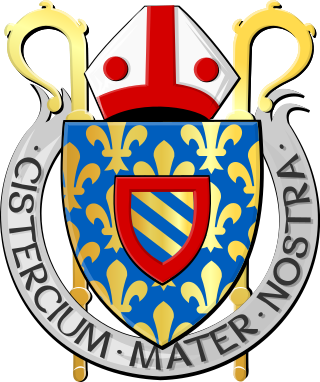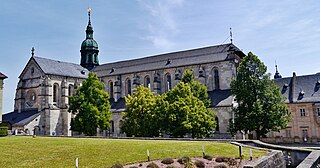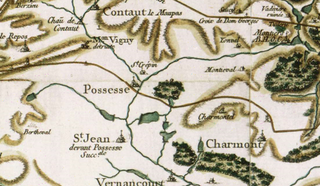
Trois-Fontaines Abbey (French : Abbaye de Sainte-Marie des Trois-Fontaines) [1] was a Cistercian abbey in the present commune of Trois-Fontaines-l'Abbaye in the French department of Marne, in the historic province of Champagne.

Trois-Fontaines Abbey (French : Abbaye de Sainte-Marie des Trois-Fontaines) [1] was a Cistercian abbey in the present commune of Trois-Fontaines-l'Abbaye in the French department of Marne, in the historic province of Champagne.
It was the first daughter-house founded by Clairvaux Abbey, one of the four Cistercian primary abbeys, and was established north of the head of navigation of the Marne at Saint-Dizier by Bernard of Clairvaux in 1118, on isolated woodland given by Hugh de Vitry, which the monks drained. It was a large community, comprising at its height some 130 monks.
The abbey was very active in its first century or so in the settlement of daughter houses:
James of Pecorara, later a cardinal, was elected abbot in 1215. The chronicler Alberic of Trois-Fontaines, who covered the years 1227 to 1241, was a monk here.
The abbey's isolated site protected it from armed attack. It fell however into the hands of commendatory abbots in 1536. Between 1716 and 1741, the abbot in commendam was Pierre Guérin de Tencin, French ambassador in Rome, who was made a cardinal in 1739. He rebuilt it, making good the damage caused by a fire in 1703. In 1790 it was sold off, and the premises largely demolished for the sake of the building materials.
The monumental gateway dates from the 18th century rebuild. It has a concave façade with four very large pilasters with Corinthian capitals and supports a terrace surrounded by a balustrade. Beyond a courtyard stands a further gateway with a coat of arms and building in the style of Louis XV.
Imposing ruins are all that remain of the abbey church, constructed between 1160 and 1190, originally about 70 metres long and 40 metres broad across the transept, on a cruciform ground plan. The portal is dominated by three large round-arched windows. The lower portion of the surround of the large rose window is extant, which fills almost the entire width of the west front. The first three bays of the nave are noticeably wider than the rest. The vault of the first is gone, but that of the next three remains, supported on massive corbels. The vaults of the next three bays collapsed in the 19th century. The side aisles have pointed barrel vaulting and are separated from the nave by pointed arches. Between 1785 and 1789 the rectangular choir and the transept with three chapels on either arm had become dilapidated almost to the point of collapse, and were replaced by a semi-circular termination on the east side of the transept.
Today the Romanesque and Early Gothic abbey church has been stabilised as a picturesque ruin. The outbuildings accommodate a bicycle museum.

An abbey is a type of monastery used by members of a religious order under the governance of an abbot or abbess. Abbeys provide a complex of buildings and land for religious activities, work, and housing of Christian monks and nuns.

Clairvaux Abbey was a Cistercian monastery in Ville-sous-la-Ferté, 15 kilometres (9.3 mi) from Bar-sur-Aube. The abbey was founded in 1115 by Bernard of Clairvaux. As a primary abbey, it was one of the most significant monasteries in the order. Dissolved during the French Revolution, it was used from 1808 to 2023 as Clairvaux Prison, a high-security correctional facility. As of 2024, work is in process to make the space available and attractive to tourists.

Kirkstall Abbey is a ruined Cistercian monastery in Kirkstall, north-west of Leeds city centre in West Yorkshire, England. It is set in a public park on the north bank of the River Aire. It was founded c. 1152. It was disestablished during the Dissolution of the Monasteries under Henry VIII.

The Cistercians, officially the Order of Cistercians, are a Catholic religious order of monks and nuns that branched off from the Benedictines and follow the Rule of Saint Benedict, as well as the contributions of the highly influential Bernard of Clairvaux, known as the Latin Rule. They are also known as Bernardines, after Saint Bernard, or as White Monks, in reference to the colour of their cowl, as opposed to the black cowl worn by Benedictines.

Fountains Abbey is one of the largest and best preserved ruined Cistercian monasteries in England. It is located approximately 3 miles (5 km) south-west of Ripon in North Yorkshire, near to the village of Aldfield. Founded in 1132, the abbey operated for 407 years, becoming one of the wealthiest monasteries in England until its dissolution, by order of Henry VIII, in 1539.

Dunbrody Abbey is a former Cistercian monastery in County Wexford, Ireland. The cross-shaped church was built in the 13th century, and the tower was added in the 15th century. With a length of 59m the church was one of the longest in Ireland. The visitor centre is run by the current Marquess of Donegall and has one of only two full sized hedge mazes in Ireland.

Cistercian architecture is a style of architecture associated with the churches, monasteries and abbeys of the Roman Catholic Cistercian Order. It was heavily influenced by Bernard of Clairvaux, who believed that churches should avoid superfluous ornamentation so as not to distract from prayer. Although a few images of religious subjects were allowed, such as the crucifix, elaborate figures common in medieval churches were prohibited. Later abbeys were constructed in Renaissance and Baroque styles, which were more ornate by nature.

Ebrach Abbey is a former Cistercian monastery in Ebrach in Oberfranken, Bavaria, Germany, and the site of a young offenders' institution.

Thoronet Abbey is a former Cistercian abbey built in the late twelfth and early thirteenth century, now restored as a museum. It is sited between the towns of Draguignan and Brignoles in the Var Department of Provence, in southeast France. It is one of the three Cistercian abbeys in Provence, along with the Sénanque Abbey and Silvacane, that together are known as "the Three Sisters of Provence."

The Abbey of Fontenay is a former Cistercian abbey located in the commune of Marmagne, near Montbard, in the département of Côte-d'Or in France. It was founded by Saint Bernard of Clairvaux in 1118, and built in the Romanesque style. It is one of the oldest and most complete Cistercian abbeys in Europe, and became a UNESCO World Heritage Site in 1981. Of the original complex comprising church, dormitory, cloister, chapter house, caldarium, refectory, dovecote and forge, all remain intact except the refectory and are well maintained. The Abbey of Fontenay, along with other Cistercian abbeys, forms a connecting link between Romanesque and Gothic architecture.

Tre Fontane Abbey, or the Abbey of Saints Vincent and Anastasius, is a Roman Catholic abbey in Rome, held by monks of the Cistercian Order of the Strict Observance, better known as Trappists. It is known for raising the lambs whose wool is used to weave the pallia of new metropolitan archbishops. The pope blesses the lambs on the feast of Saint Agnes on January 21. The wool is prepared, and he gives the pallia to the new archbishops on the Solemnity of Saints Peter and Paul, the Holy Apostles.

The Abbey of Santa Maria di Rovegnano is a Cistercian monastic complex in the comune of Milan, Lombardy, northern Italy. The borgo that has developed round the abbey was once an independent commune called Chiaravalle Milanese, now included in Milan and referred to as the Chiaravalle district.

Early Gothic is the term for the first period of Gothic architecture which lasted from about 1120 until about 1200. The early Gothic builders used innovative technologies to resolve the problem of masonry ceilings which were too heavy for the traditional arched barrel vault. The solutions to the problem came in the form of the rib vault, where thin stone ribs passed the weight of the ceiling to rows of columns and outside the walls to another innovation, the flying buttress.

Saint-Génis-des-Fontaines Abbey is a Benedictine abbey in Saint-Génis-des-Fontaines, Pyrénées-Orientales, France. It was dedicated to Saint Genesius and Saint Michael, to whom the surviving church is still dedicated.

The Monastery of Santa María de Huerta is a Cistercian monastery located in Santa María de Huerta, a town of the Spanish Province of Soria, within the autonomous community of Castile and León. The first stone of the building was laid by Alfonso VII of León and Castile in 1179.

Aduard Abbey is a former Cistercian abbey in the village of Aduard about 8 kilometres to the north-west of Groningen in the Netherlands, founded in 1192 and dissolved in 1580.

The Abbey of Monthiers-en-Argonne was a Cistercian monastery located in Possesse in the diocese of Châlons-sur-Marne in the County of Champagne. A daughter house of Trois-Fontaines and of the lineage of Clairvaux, it was dedicated to Saints Nicholas and Mary (Notre-Dame). According to Leopold Janauschek, its order number was 194.

Romanesque architecture appeared in France at the end of the 10th century, with the development of feudal society and the rise and spread of monastic orders, particularly the Benedictines, which built many important abbeys and monasteries in the style. It continued to dominate religious architecture until the appearance of French Gothic architecture in the Île-de-France between about 1140 and 1150.

Gothic cathedrals and churches are religious buildings created in Europe between the mid-12th century and the beginning of the 16th century. The cathedrals are notable particularly for their great height and their extensive use of stained glass to fill the interiors with light. They were the tallest and largest buildings of their time and the most prominent examples of Gothic architecture. The appearance of the Gothic cathedral was not only a revolution in architecture; it also introduced new forms in decoration, sculpture, and art.

Beaugerais Abbey is a former Cistercian abbey, located in what is now the commune of Loché-sur-Indrois, in the Indre-et-Loire département of France.